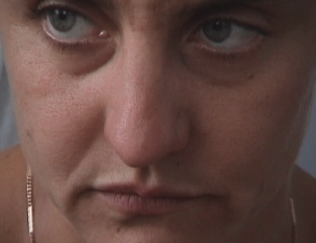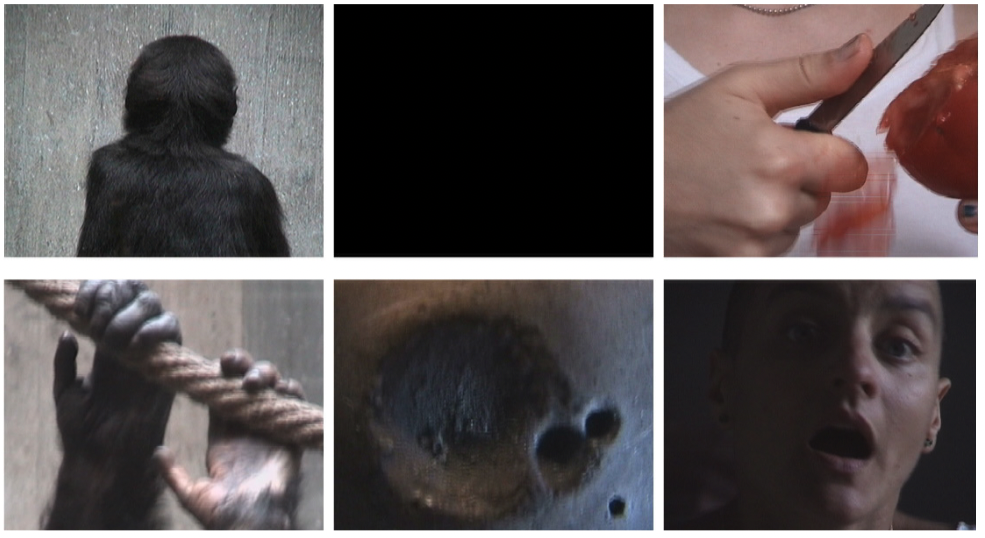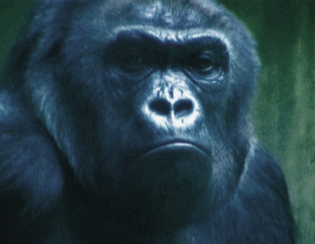„Konsumbäckerei“ Solothurn, SchauspielerInnen: Silvia Buonvicini und Jo Dunkel, Interfacelösungen, technische Mitarbeit: Valentin Spiess, Programmierung: Dani Meier
„Die Augen eines Tieres sind, wenn sie einen Menschen betrachten, aufmerksam und wachsam. Das gleiche Tier wird wahrscheinlich andere Tiere auf gleiche Weise ansehen. Für den Menschen ist kein besonderer Blick reserviert. Doch keine andere Gattung als der Mensch wird den Blick des Tieres als vertraut empfinden. Andere Tiere nimmt der Blick gefangen. Der Mensch jedoch wird sich, indem er den Blick erwidert, seiner selbst bewusst.“ (John Berger, Das Leben der Bilder)
Im Raum sind fünf Monitore in einem Halbkreis (ca. 8 Meter Durchmesser) angeordnet, auf denen ein monochromes dunkles Grau zu sehen ist. Sie sind die einzige Lichtquelle. Nähert man sich einem Monitor, erscheint für einen kurzen Moment ein Bild. Bewegt man sich zu einem anderen Monitor, blitzt dort ein anderes Bild auf.
Der Betrachter erfährt, dass seine physische Präsenz Bildwelten auslöst. Je nach Standort und Bewegung im Raum erscheinen die Bilder häufiger oder seltener und unterschiedlich lange. Der Raum ist mit Sensoren ausgestattet, die den Standort der Person erfassen. Sobald jemand in den Bereich eines Sensors tritt, wird ein Bild auf dem entsprechenden Monitor angezeigt. Durchquert jemand das ganze Sensorenfeld, erscheinen auf den Monitoren Schnittfolgen von Bildern. Diese Bilder sind nur kurz sichtbar, was ein Nachbild erzeugt, das sich mit dem nächsten Bild oder Schwarz überlagert. Die Zuschauer werden mit einem Stakkato von Bildfragmenten konfrontiert, die sich assoziativ vermischen.
Bildfamilien
Der Tierische Blick: Aufnahmen von Gorillas im Basler Zoo, die menschliches Verhalten widerspiegeln. Die Szenen zeigen archetypische Gesten.
Interaktion der Gefühle: Szenen mit drei Schauspielern, die auf improvisierte Aufgaben reagieren. Der Fokus liegt auf emotionalen Ausdruck und Gesichtern.
Nahbereich/Macrobereich: Nahaufnahmen von Menschen und Gorillas, die isolierte Körperteile wie Hände und Füße zeigen.
Diese Installation fordert den Betrachter auf, sich zu bewegen, um die verborgenen Bildwelten zu entdecken.
—
The Hidden Principle
“Konsumbäckerei” Solothurn, Actors: Silvia Buonvicini and Jo Dunkel, Interface Solutions and Technical Collaboration: Valentin Spiess, Programming: Dani Meier
“The eyes of an animal, when they look at a man, are attentive and alert. The same animal will probably look at other animals in the same way. There is no special gaze reserved for man. But no other species except man will feel that the animal’s gaze is familiar. Other animals are held by the gaze. The man, however, becomes aware of himself as he returns the gaze.” (John Berger, “Why Look at Animals?”)
In a darkened room, five monitors are arranged in a semi-circle with a diameter of approximately eight meters. They display a monochrome dark grey and act as the only light sources in the space. As a viewer approaches one of the monitors, an image briefly appears. When they move toward another monitor, a different image flashes up. The viewer gradually realizes that their physical presence triggers the appearance of these visual worlds. Depending on their location and movements within the space, images appear more or less frequently and vary in duration. Sensors installed throughout the room detect the position of the visitor. As soon as someone steps into the range of a sensor, a corresponding monitor displays an image. If a person moves through the entire sensor field, the monitors show rapid sequences of images. These appear only for an instant, creating afterimages that blend with the next image or dissolve into darkness. The result is a staccato of fragmented impressions that mix associatively in the viewer’s perception.
The visual material is organized into image families. “The Animal Gaze” shows footage of gorillas in the Basel Zoo whose behaviors reflect human traits, focusing on archetypal gestures. “Emotional Interactions” presents scenes with three actors reacting to improvised tasks, highlighting emotional expression and facial movement. “Close-up/Macro Realm” features intimate views of humans and gorillas, focusing on isolated body parts such as hands and feet.
This installation invites viewers to actively explore the space, discovering the hidden images through movement. It creates a perceptual feedback loop in which human presence becomes both observer and trigger of fleeting visual moments.


